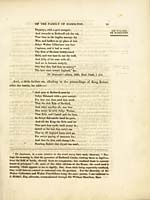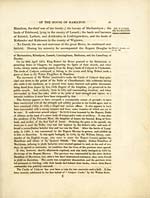Download files
Complete book:
Individual page:
Thumbnail gallery: Grid view | List view

36 HISTORICAL AND GENEALOGICAL MEMOIRS
SIR WALTER And the Queyne that thai takyn had
DE HAMILTON. ^ p^,^ as before said I ;
And hyr douchtre Dame Maiory,
The Erie wes changyt for thir thre,"* &c.
Book Ninth, I. 848.
Douglas and Wood's King Robert the Bruce bestowed on him several lands and baronies,
peerages. ^^ ^ ^ ^. ft ^ ^ ^^ ^ ^ barony of Cadyow,+ (now called
Foedera AugH*, * The Earl of Hereford was exchanged for the wife, sister, and daughter of King
«'• 446. Robert, for Robert Wishart, Bishop of Glasgow, and the young Earl of Mar.
Caled. vol. iii. t " In various ancient charters, from the twelfth to the fifteenth century, the name
of the barony, and of the church of the parish, appears in the various forms of Cadi-
how, Cadyou, Cadyhow, and Cadyow. The origin of the name is very obscure. In
the ancient Welsh MSS. mention is made of a place in Scotland called Rodwyz-Ceidio,
which signifies the boundary or rampart of Ceidio, a chieftain who is often mentioned
in these MSS. ; but there is nothing which can show that Cadyow derived its name
from this chieftain Ceidio. Cad and Caid, in the Gaelic, signifies a rock or rocky
height, Cad-eo the rocky height of the grave, and Cad-id'a the rocky height of the
yew-tree."
The ruins of the Castle of Cadyow, as represented in the frontispiece, stand in a
romantic situation on the summit of a precipitous rock of a reddish colour, the foot
of which is washed by the Avon. It was surrounded by a forest of very fine oaks, of
which many, of an extraordinary size and age, still remain ; and there is much natural
wood of other kinds on the banks of the Avon .
It is not known who were the founders of this castle, which appears to have been
built at a very remote period. In ancient times it was a royal residence, as is evident
from the charters of many of our Scottish Kings, during the twelfth and thirteenth
centuries, being dated " Apud Cadyow:' David the First made a grant to the church
of Glasgow, in elemosina pura, of the tenth of his can or kain in Stragrief, (or Ren-
frew,) in Cunninghame, Kyle, and Carrick, which grant was dated from Cadihou in
Clydesdale.
The manor of Cadyow was in possession of the crown during his r-ign ; and the
same monarch, with the assent of his son Earl Henry, granted the cl arch of Cadi-
how, with its pertinents, to the church and Bishops of Glasgow ; and this grant was
confirmed by the bulls of Pope Alexander, in 1170 and 1178, of Pope Lucius in 1181,
and of Pope Urban in 1 186.
Along with other lands in Clydesdale, the lands and Castle of Cadyow seem after-
wards to have become the property of a branch of the once powerful family of the
Cummings. During the contested reigu of John Baliol, the lands of Cadyow had
fallen into the possession of the crown ; for we find that when that monarch contracted
his son Edward Baliol to a niece of the King of France, with a portion of 25,000
livres tournois, he secured her jointure upon certain of his lands in France, and upon
some of the crown lands in Scotland, viz. the lands and Castle of Cadyow, the lands
SIR WALTER And the Queyne that thai takyn had
DE HAMILTON. ^ p^,^ as before said I ;
And hyr douchtre Dame Maiory,
The Erie wes changyt for thir thre,"* &c.
Book Ninth, I. 848.
Douglas and Wood's King Robert the Bruce bestowed on him several lands and baronies,
peerages. ^^ ^ ^ ^. ft ^ ^ ^^ ^ ^ barony of Cadyow,+ (now called
Foedera AugH*, * The Earl of Hereford was exchanged for the wife, sister, and daughter of King
«'• 446. Robert, for Robert Wishart, Bishop of Glasgow, and the young Earl of Mar.
Caled. vol. iii. t " In various ancient charters, from the twelfth to the fifteenth century, the name
of the barony, and of the church of the parish, appears in the various forms of Cadi-
how, Cadyou, Cadyhow, and Cadyow. The origin of the name is very obscure. In
the ancient Welsh MSS. mention is made of a place in Scotland called Rodwyz-Ceidio,
which signifies the boundary or rampart of Ceidio, a chieftain who is often mentioned
in these MSS. ; but there is nothing which can show that Cadyow derived its name
from this chieftain Ceidio. Cad and Caid, in the Gaelic, signifies a rock or rocky
height, Cad-eo the rocky height of the grave, and Cad-id'a the rocky height of the
yew-tree."
The ruins of the Castle of Cadyow, as represented in the frontispiece, stand in a
romantic situation on the summit of a precipitous rock of a reddish colour, the foot
of which is washed by the Avon. It was surrounded by a forest of very fine oaks, of
which many, of an extraordinary size and age, still remain ; and there is much natural
wood of other kinds on the banks of the Avon .
It is not known who were the founders of this castle, which appears to have been
built at a very remote period. In ancient times it was a royal residence, as is evident
from the charters of many of our Scottish Kings, during the twelfth and thirteenth
centuries, being dated " Apud Cadyow:' David the First made a grant to the church
of Glasgow, in elemosina pura, of the tenth of his can or kain in Stragrief, (or Ren-
frew,) in Cunninghame, Kyle, and Carrick, which grant was dated from Cadihou in
Clydesdale.
The manor of Cadyow was in possession of the crown during his r-ign ; and the
same monarch, with the assent of his son Earl Henry, granted the cl arch of Cadi-
how, with its pertinents, to the church and Bishops of Glasgow ; and this grant was
confirmed by the bulls of Pope Alexander, in 1170 and 1178, of Pope Lucius in 1181,
and of Pope Urban in 1 186.
Along with other lands in Clydesdale, the lands and Castle of Cadyow seem after-
wards to have become the property of a branch of the once powerful family of the
Cummings. During the contested reigu of John Baliol, the lands of Cadyow had
fallen into the possession of the crown ; for we find that when that monarch contracted
his son Edward Baliol to a niece of the King of France, with a portion of 25,000
livres tournois, he secured her jointure upon certain of his lands in France, and upon
some of the crown lands in Scotland, viz. the lands and Castle of Cadyow, the lands
Set display mode to:
![]() Universal Viewer |
Universal Viewer | ![]() Mirador |
Large image | Transcription
Mirador |
Large image | Transcription
Images and transcriptions on this page, including medium image downloads, may be used under the Creative Commons Attribution 4.0 International Licence unless otherwise stated. ![]()
| Histories of Scottish families > Historical and genealogical memoirs of the House of Hamilton > (46) Page 36 |
|---|
| Permanent URL | https://digital.nls.uk/95390339 |
|---|
| Description | A selection of almost 400 printed items relating to the history of Scottish families, mostly dating from the 19th and early 20th centuries. Includes memoirs, genealogies and clan histories, with a few produced by emigrant families. The earliest family history goes back to AD 916. |
|---|

